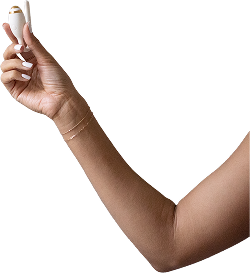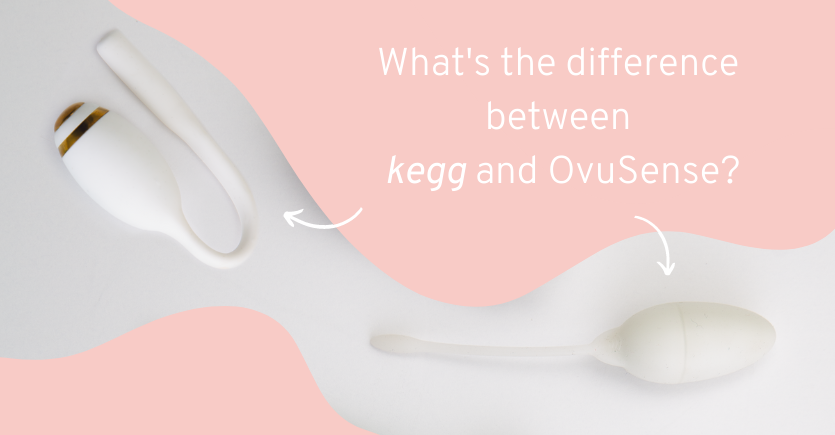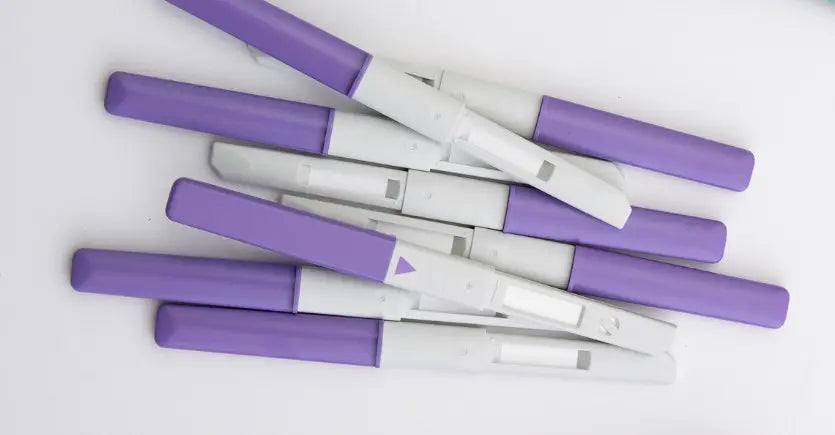At a Glance:
- OvuSense tracks continuous core body temperature through a vaginal device that is inserted and worn overnight
- kegg is inserted for 2 minutes a day and detects the changes in cervical fluid to accurately display the full fertile window
- OvuSense is helpful for showing that ovulation has occurred after the fact, but does not help the user time their trying to conceive efforts.
- kegg helps the user see precisely when to time their trying to conceive efforts to maximize their chances of conception
- While OvuSense must be worn overnight, kegg is used for 2 minutes a day in a 2-hour window that is convenient for the user
- The OvuSense Starter Pack is $299 for 12 months
- kegg is $259 with no recurring costs
We recently wrote a detailed post analyzing the fertility trackers space and the main solutions available for women in their reproductive age. These days we’ve been asked very often what makes kegg different from OvuSense. Formerly known as “OvuSense”
As we can see, these two devices are very alike in shape. They are both used to help track a woman’s fertility cycle and both are inserted in the vagina … and that’s where the similarities end.
As we can see, these two devices are very alike in shape. They are both used to help track a woman’s fertility cycle and both are inserted in the vagina … and that’s where the similarities end.
What is being tracked?
OvuSense tracks continuous core body temperatures (cCBT). Continuous core body temperature is the body’s internal temperature, not the peripheral temperature that we measure with an ear, mouth, or skin thermometer. By measuring the minute fluctuations in internal temperature caused by progesterone, it can let a user know after the fact if ovulation has occurred. OvuSense claims to detect impending ovulation 1 day in advance.
kegg tracks the changes in the cervical fluid which shift with the hormonal changes in the cycle. As a result, the kegg user can see the full fertile window to know when to optimally time their trying to conceive efforts. On the kegg app, the fertile window most often resembles a “dip” or “valley” in your kegg graph. After ovulation, the shift from estrogen to progesterone dominance results in a rise in your kegg data. The kegg user sees an advanced prediction of when their fertile window, based on past trend data, is likely to fall. To make the results more straightforward, kegg also shows your daily fertility status on the app: ‘Low’, ‘Possible’ and ‘Likely’. In real-time, the kegg user sees their overall trend to spot their fertile valley.
kegg tracks the changes in the cervical fluid which shift with the hormonal changes in the cycle. As a result, the kegg user can see the full fertile window to know when to optimally time their trying to conceive efforts. On the kegg app, the fertile window most often resembles a “dip” or “valley” in your kegg graph. After ovulation, the shift from estrogen to progesterone dominance results in a rise in your kegg data. The kegg user sees an advanced prediction of when their fertile window, based on past trend data, is likely to fall. To make the results more straightforward, kegg also shows your daily fertility status on the app: ‘Low’, ‘Possible’ and ‘Likely’. In real-time, the kegg user sees their overall trend to spot their fertile valley.
Note: No consumer device can confirm ovulation with 100% accuracy without urine or blood work and therefore kegg can only suggest when ovulation might have occurred.
How long is it worn?
OvuSense is inserted and worn through the night during sleep for a minimum of 4 hours.
The kegg reading takes only two minutes a day. The kegg user elects to take the fertility reading or to complete the kegel exercises (kegg doubles as a kegel ball) and the fertility reading.
The kegg reading takes only two minutes a day. The kegg user elects to take the fertility reading or to complete the kegel exercises (kegg doubles as a kegel ball) and the fertility reading.
Down to details
OvuSense is inserted in the vagina and is worn continuously throughout the night. During this time it takes a temperature reading every 5 minutes. In the morning OvuSense is removed and the user uploads the data via bluetooth to the mobile app. An algorithm selects a single temperature chosen for that day based on the readings taken throughout the night.
If OvuSense is taken out when you wake in the night to use the bathroom. It needs to be rinsed before it is reinserted. OvuSense has to be worn for a minimum of 4 hours and should be used around the same time each night. Irregular sleep schedules will interfere with accurate readings.
OvuSense must be removed before intercourse, rinsed off and reinserted. It should not be worn when a woman has a fever or suspects she has a fever.
kegg takes a reading in less than 2 minutes a day. kegg users can conveniently choose a 2 hour time frame to take their reading with kegg each day. kegg is inserted into the vagina and detects the changes in electrolytes in the cervical fluid. You can read more about the science behind kegg.
kegg harnesses the power of cloud computing and advanced algorithms to analyze the user’s data and provide a fertile window prediction. The fertile window prediction is a 5-day window (marked in green on the app), placed at the beginning of your cycle, during which time kegg predicts your greatest likelihood of conception for your entire cycle.
The kegg user can see their fertile window unfold in real-time. Each kegg reading is plotted on the kegg chart. A trendline is displayed to help the user see the overall trend of the readings to spot the fertile valley. The descending and low readings are associated with a vaginal environment that is hospitable to sperm.
When kegg is removed it automatically uploads its test data to the kegg mobile fertility app, in real-time.
If OvuSense is taken out when you wake in the night to use the bathroom. It needs to be rinsed before it is reinserted. OvuSense has to be worn for a minimum of 4 hours and should be used around the same time each night. Irregular sleep schedules will interfere with accurate readings.
OvuSense must be removed before intercourse, rinsed off and reinserted. It should not be worn when a woman has a fever or suspects she has a fever.
kegg takes a reading in less than 2 minutes a day. kegg users can conveniently choose a 2 hour time frame to take their reading with kegg each day. kegg is inserted into the vagina and detects the changes in electrolytes in the cervical fluid. You can read more about the science behind kegg.
kegg harnesses the power of cloud computing and advanced algorithms to analyze the user’s data and provide a fertile window prediction. The fertile window prediction is a 5-day window (marked in green on the app), placed at the beginning of your cycle, during which time kegg predicts your greatest likelihood of conception for your entire cycle.
The kegg user can see their fertile window unfold in real-time. Each kegg reading is plotted on the kegg chart. A trendline is displayed to help the user see the overall trend of the readings to spot the fertile valley. The descending and low readings are associated with a vaginal environment that is hospitable to sperm.
When kegg is removed it automatically uploads its test data to the kegg mobile fertility app, in real-time.
Cervical fluid or temps? Which is more helpful?
Without cervical fluid, sperm cannot survive within the female reproductive tract. In fact, with the help of cervical fluid, sperm can be kept alive for up to 5 days! No other biological marker has been proven to give such reliable, real-time information regarding the fertile window.
In the week before ovulation, shifting hormone levels cause the cervix to secrete cervical fluid (also known as cervical mucus). Cervical mucus can take on different textures and sensations throughout the fertility cycle; more importantly for kegg, the electrolyte composition of cervical fluid changes to be more hospitable to sperm. Women with regular cycles and irregular cycles typically have the most hospitable cervical fluid 2–3 days before ovulation. Intercourse on these days tend to be the best days for conception.
Continuous core body temperature is said to be more accurate than basal body temperatures (BBT) but both can help confirm ovulation after and if it has happened. While this is helpful for knowing when the fertile window has ended, it does not help the user know when to time their trying to conceive efforts. This leaves those who are trying to conceive in a guessing game before the temperatures rise. Temperatures can also be easily skewed by irregular sleep patterns, sickness, travel, certain medications, and more.
With kegg, users can conveniently detect the fertile window earlier and more precisely than when testing with body temperature alone. When you know your fertile window, you’re 4x more likely to conceive!*
Continuous core body temperature is said to be more accurate than basal body temperatures (BBT) but both can help confirm ovulation after and if it has happened. While this is helpful for knowing when the fertile window has ended, it does not help the user know when to time their trying to conceive efforts. This leaves those who are trying to conceive in a guessing game before the temperatures rise. Temperatures can also be easily skewed by irregular sleep patterns, sickness, travel, certain medications, and more.
With kegg, users can conveniently detect the fertile window earlier and more precisely than when testing with body temperature alone. When you know your fertile window, you’re 4x more likely to conceive!*




